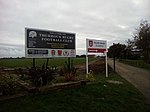Thurrock and Basildon College
Defunct universities and colleges in EnglandEducation in ThurrockEducational institutions disestablished in 2010Educational institutions with year of establishment missingFurther education colleges in Essex
Thurrock and Basildon College was a further education college in Grays, Essex, England (Woodview Campus) and Basildon, Essex, England (Nethermayne Campus). It was formed by the merger of Thurrock Technical College and Basildon College. The college merged with South East Essex College of Arts and Technology on 1 January 2010 to form South Essex College.The Nethermayne Campus of Basildon college opened on 13 September 1971.
Excerpt from the Wikipedia article Thurrock and Basildon College (License: CC BY-SA 3.0, Authors).Thurrock and Basildon College
Thurrock
Geographical coordinates (GPS) Address Nearby Places Show on map
Geographical coordinates (GPS)
| Latitude | Longitude |
|---|---|
| N 51.48526 ° | E 0.35483 ° |
Address
RM16 2EN Thurrock
England, United Kingdom
Open on Google Maps








